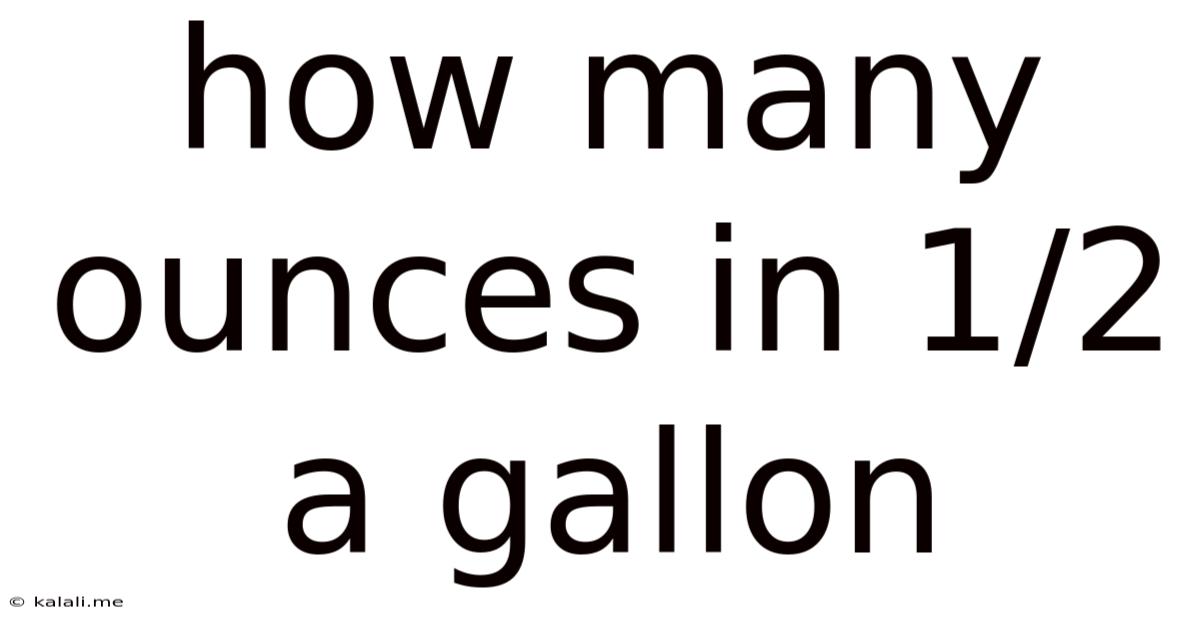How Many Ounces In 1/2 A Gallon
Kalali
Jul 22, 2025 · 4 min read

Table of Contents
How Many Ounces in 1/2 a Gallon? A Comprehensive Guide to Volume Conversions
Knowing how many ounces are in half a gallon is a common question that arises in various contexts, from cooking and baking to understanding liquid measurements in different units. This comprehensive guide will not only answer that question but delve deeper into the world of volume conversions, providing you with the knowledge and tools to confidently handle similar conversions in the future. This includes understanding the relationship between gallons, ounces, pints, quarts, and even metric equivalents like liters and milliliters.
Understanding US vs. Imperial Gallons: A Crucial Distinction
Before we dive into the calculation, it's crucial to address a key difference that often causes confusion: the distinction between US liquid gallons and imperial gallons. These two units, while both called "gallons," represent different volumes. This difference stems from historical variations in measurement standards.
-
US Liquid Gallon: This is the standard gallon used in the United States and some other countries. It's defined as 128 US fluid ounces.
-
Imperial Gallon: This is the gallon used in the United Kingdom and some Commonwealth countries. It's slightly larger than the US liquid gallon, containing approximately 160 fluid ounces.
Throughout this article, we'll focus on the US liquid gallon unless otherwise specified. Always clarify which gallon you're working with to avoid errors in your calculations.
Calculating Ounces in Half a Gallon (US Liquid)
Now, let's tackle the primary question: how many ounces are in half a gallon?
Since 1 US liquid gallon contains 128 fluid ounces, half a gallon (1/2 gallon) contains:
128 ounces / 2 = 64 fluid ounces
Therefore, there are 64 fluid ounces in half a gallon (US liquid).
Beyond the Basics: A Deeper Dive into Volume Conversions
Understanding the relationship between ounces and gallons is just the beginning. Mastering volume conversions involves familiarity with other common units like pints and quarts. Let's explore these conversions in detail:
Gallons, Quarts, Pints, and Cups: The US Liquid System
The US liquid system uses a consistent set of relationships:
- 1 gallon = 4 quarts
- 1 quart = 2 pints
- 1 pint = 2 cups
- 1 gallon = 8 pints
- 1 gallon = 16 cups
- 1 quart = 32 fluid ounces
- 1 pint = 16 fluid ounces
- 1 cup = 8 fluid ounces
Understanding these relationships allows you to easily convert between any of these units. For example:
- To convert gallons to pints, multiply the number of gallons by 8.
- To convert pints to ounces, multiply the number of pints by 16.
- To convert quarts to ounces, multiply the number of quarts by 32.
Working with Fractions and Decimals:
Often, you'll encounter situations requiring conversions involving fractions or decimals of gallons, quarts, or pints. The principles remain the same; you simply need to apply the appropriate multiplication or division.
For example:
- 1.5 gallons: 1.5 gallons * 128 ounces/gallon = 192 ounces
- 3/4 gallon: 3/4 gallon * 128 ounces/gallon = 96 ounces
- 2.25 quarts: 2.25 quarts * 32 ounces/quart = 72 ounces
Metric Conversions: Adding Liters and Milliliters
While the US system is commonly used in the United States, the metric system (liters and milliliters) is the international standard. Knowing how to convert between the two is essential for global communication and understanding.
- 1 US liquid gallon ≈ 3.785 liters
- 1 liter = 1000 milliliters
To convert gallons to liters, multiply the number of gallons by 3.785. Conversely, to convert liters to gallons, divide the number of liters by 3.785.
Example:
- 0.5 gallons ≈ 0.5 gallons * 3.785 liters/gallon ≈ 1.89 liters
Practical Applications: Where You'll Use These Conversions
These volume conversions are essential in many everyday situations:
- Cooking and Baking: Recipes often specify ingredients in both volume and weight measurements. Accurate conversions are crucial for successful results.
- Home Improvement: Projects involving liquids like paint, sealant, or stain require precise measurements to ensure proper coverage and avoid waste.
- Gardening: Watering plants, mixing fertilizers, and using pesticides often involve specific liquid amounts.
- Science Experiments: Many scientific experiments rely on accurate measurements of liquids.
- Fuel Efficiency: Calculating fuel consumption often involves converting between gallons and liters.
Troubleshooting Common Conversion Mistakes
Several common mistakes can occur when performing volume conversions:
- Confusing US and Imperial Gallons: Always ensure you are using the correct gallon definition for your context.
- Incorrect Multiplication or Division: Double-check your calculations to prevent errors.
- Using Incorrect Conversion Factors: Always refer to accurate conversion tables to ensure you are using the correct factors.
Conclusion: Mastering Volume Conversions for Everyday Use
Understanding how many ounces are in half a gallon, and more broadly, mastering volume conversions, is a valuable skill applicable across many areas of life. By understanding the relationships between gallons, quarts, pints, ounces, and their metric equivalents, you can confidently handle various measurement tasks, from cooking to scientific endeavors. Remember to always double-check your units and calculations to avoid errors, and consult reliable resources for accurate conversion factors. With practice, these conversions will become second nature.
Latest Posts
Latest Posts
-
1 Tbsp Minced Onion To Onion Powder
Jul 22, 2025
-
How Much Land Do The Robertson Family Own
Jul 22, 2025
-
How To Write 1 Million In Figures
Jul 22, 2025
-
Drop A Heart Break A Name Meaning
Jul 22, 2025
-
When Does The Condensing Pressure Stop Rising
Jul 22, 2025
Related Post
Thank you for visiting our website which covers about How Many Ounces In 1/2 A Gallon . We hope the information provided has been useful to you. Feel free to contact us if you have any questions or need further assistance. See you next time and don't miss to bookmark.